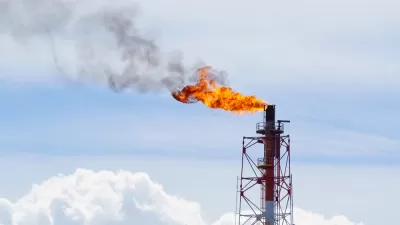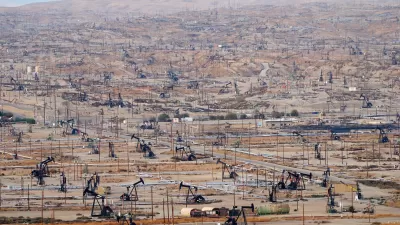While billed as an "anti-fracking initiative," Measure Z in Monterey County, the 4th-largest oil-producing county in California, does far more. It bans new oil drilling and requires the cleaning of wastewater from current drilling operations.
While Measure Z is commonly referred to as the "anti-fracking initiative," there is no fracking in the county, for good reason.
"According to a representative for California’s Division of Oil, Gas, and Geothermal Resources (DOGGR), it...isn’t the most effective way to get the thick crude oil out of San Ardo’s ground, which is where the majority of the county’s oil production takes place," reports Brittany Nielsen for KSBW.
Steam injection is the most effective way. According to the state Department of Conservation, 15 times more water than oil is taken out of the ground in that proc
And that wastewater has to be disposed of. Readers may recall that the disposal of wastewater from drilling operations in Kansas, Texas, and Oklahoma has been associated with a flurry of earthquakes, the most powerful being a 5.6 quake in Oklahoma in September. In addition, they were likely the cause the earthquakes in Kern County in California in 2005.
However, Measure Z isn't aimed at seismic activity. It's focused on cleaning the wastewater.
About a third of that wastewater is currently cleaned through reverse osmosis, put in ponds, and percolates back into the ground. The rest is re-injected back where it came from, and that is what Measure Z would no longer allow, unless the water is cleaned.
Under the measure, a spokesperson for the Pro-Measure Z group, Protect Monterey County, says operators would need to first clean wastewater, and that would require expensive treatment plants to continue oil production as it currently exists.
Taken together with the prohibition of new drilling, it would well mean the end of oil drilling in the county, claim the measure's opponents, which would have a dire financial effect for all recipients of their property taxes. An image on the video (1:56) shows that during the 2015-16 fiscal year, schools received $5.476 million and the county $2.157 million.
Monterey County Weekly endorses the measure:
When opponents of Measure Z say it would do more than ban fracking, they’re right: It would force the industry to adapt within its existing footprint, treating all of its water and finding a new way to dispose of wastewater. We think that’s a good thing.
By this correspondent's tracking, Measure Z is the fifth "anti-fracking initiative" placed on county ballots.
Two years ago at this time, San Benito, Santa Barbara, and Mendocino County had such measures. Only the Santa Barbara measure failed, "the only one of the three places where well operators use the technique, and where they are seeking to expand it," according to KPCC.
Butte County (where Chico is located) passed a fracking ban last June with 70 percent of the vote.
“If they win in Monterey, it sets a precedent,” Amy Myers Jaffe, executive director for energy and sustainability at the University of California, Davis, told Amy Harder of The Wall Street Journal. “It would show there’s real political force behind this movement.”
Even if Measure Z should pass — litigation will likely follow over the issues of state vs. county regulation and whether the measure constitutes a 'taking.'
Related:
- Wall Street Journal: Can Fracking Bans Succeed in Oil and Gas Country? All Eyes Are on Monterey, Nov. 3, 2016
- Ballotpedia: Monterey County, California, Ban on Oil and Gas Drilling, Measure Z (November 2016)
Also on Planetizen:
-
Drilling Bans on Three California County Ballots Today, November 4, 2014
- Fracking Wastewater Dumped into Protected California Aquifers, October 9, 2014
Thanks to Katie Herzog of Grist for reporting on:
- Florida’s Amendment 1 is an anti-solar ballot measure disguised as a pro-solar ballot measure.
- Nevada’s Question 3 would amend the state constitution to break the monopoly that utility NV Energy currently has on the electricity market.
- Colorado’s Amendment 71 appears to be “raising the bar” for amending the state constitution, but it could limit fracking bans and grassroots environmental action.
FULL STORY: Is Measure Z really about fracking Monterey County?

Planetizen Federal Action Tracker
A weekly monitor of how Trump’s orders and actions are impacting planners and planning in America.

Congressman Proposes Bill to Rename DC Metro “Trump Train”
The Make Autorail Great Again Act would withhold federal funding to the system until the Washington Metropolitan Area Transit Authority (WMATA), rebrands as the Washington Metropolitan Authority for Greater Access (WMAGA).

DARTSpace Platform Streamlines Dallas TOD Application Process
The Dallas transit agency hopes a shorter permitting timeline will boost transit-oriented development around rail stations.

Renters Now Outnumber Homeowners in Over 200 US Suburbs
High housing costs in city centers and the new-found flexibility offered by remote work are pushing more renters to suburban areas.

The Tiny, Adorable $7,000 Car Turning Japan Onto EVs
The single seat Mibot charges from a regular plug as quickly as an iPad, and is about half the price of an average EV.

Supreme Court Ruling in Pipeline Case Guts Federal Environmental Law
The decision limits the scope of a federal law that mandates extensive environmental impact reviews of energy, infrastructure, and transportation projects.
Urban Design for Planners 1: Software Tools
This six-course series explores essential urban design concepts using open source software and equips planners with the tools they need to participate fully in the urban design process.
Planning for Universal Design
Learn the tools for implementing Universal Design in planning regulations.
Municipality of Princeton
Roanoke Valley-Alleghany Regional Commission
City of Mt Shasta
City of Camden Redevelopment Agency
City of Astoria
Transportation Research & Education Center (TREC) at Portland State University
US High Speed Rail Association
City of Camden Redevelopment Agency
Municipality of Princeton (NJ)




























